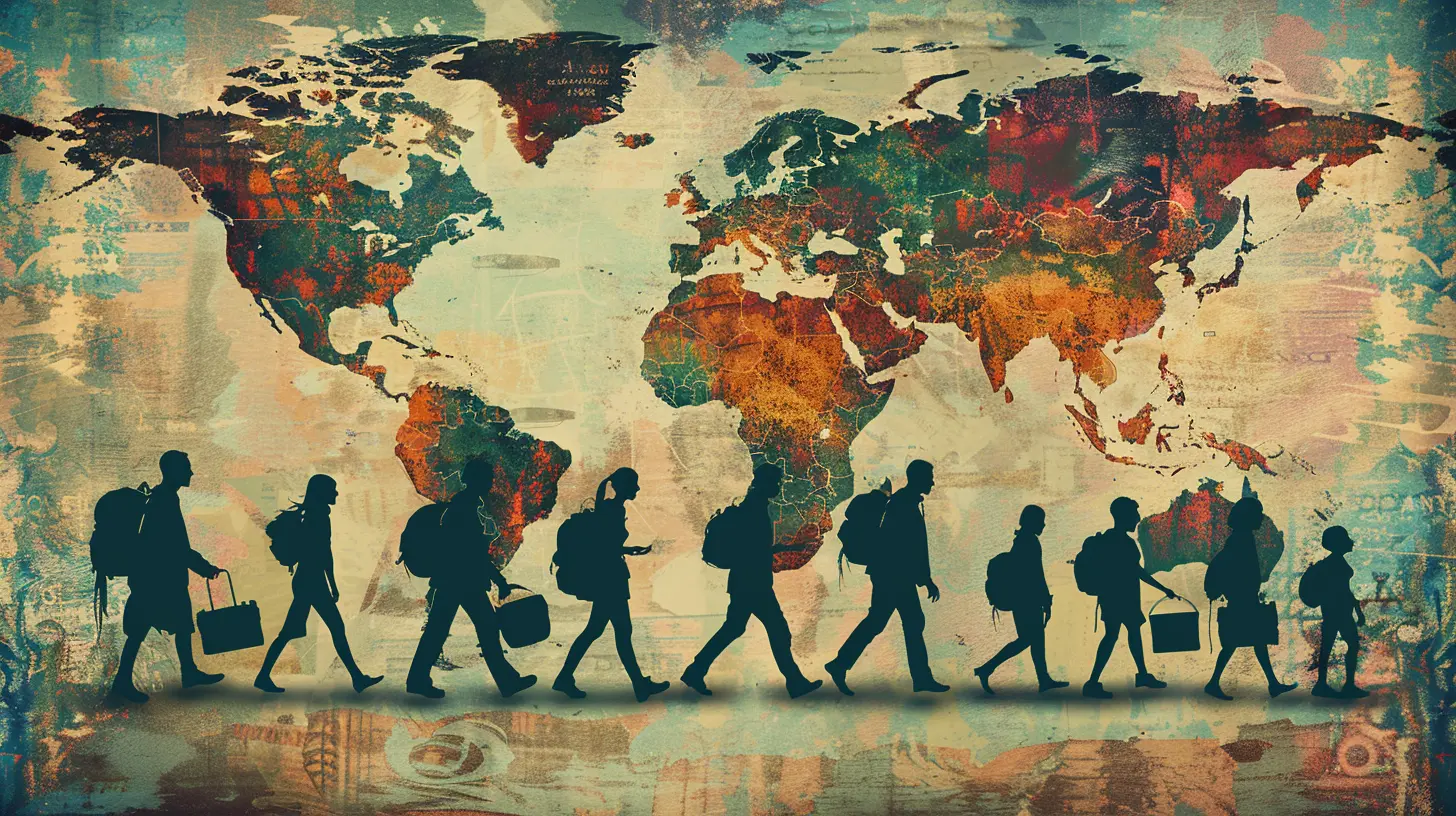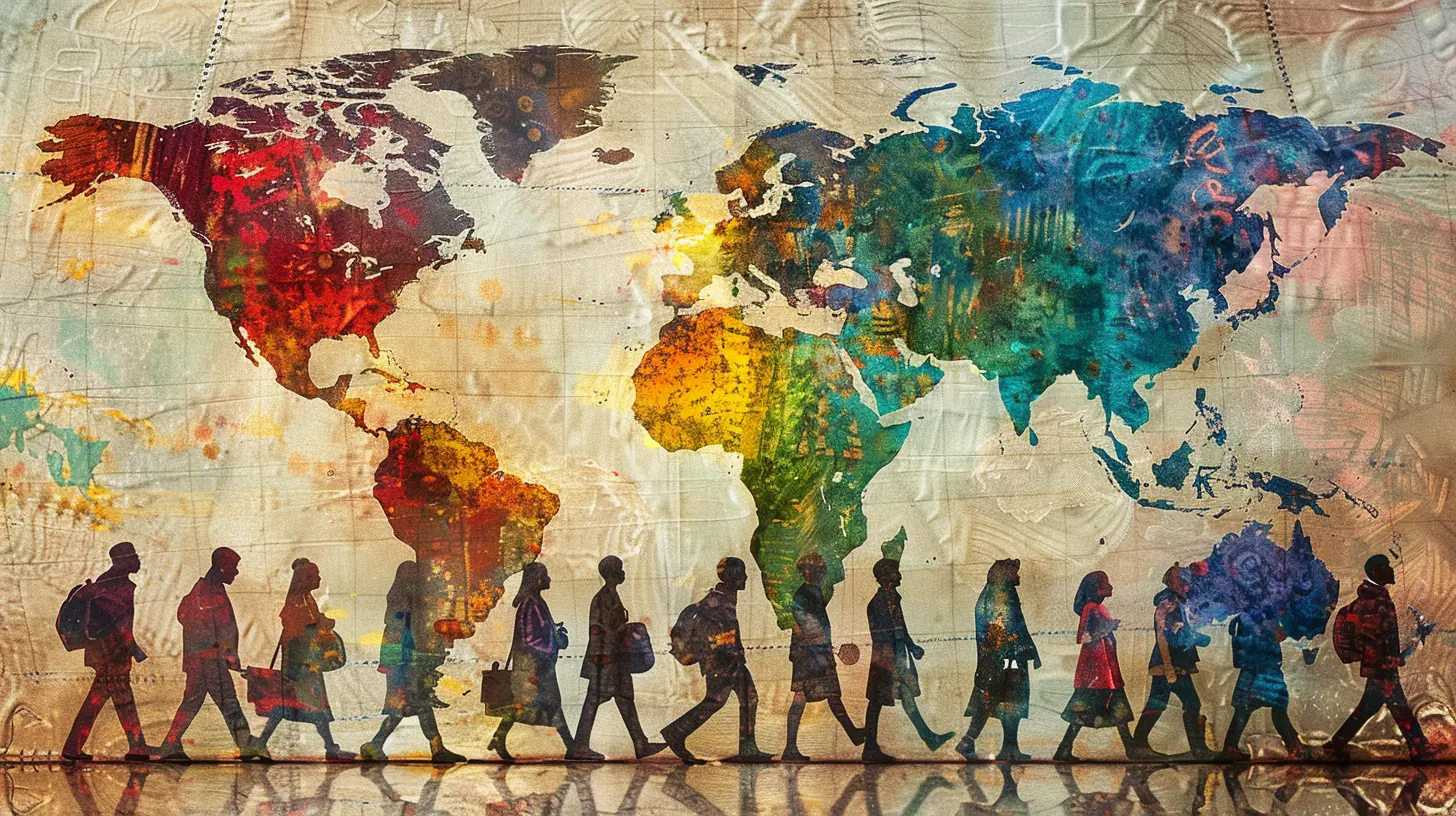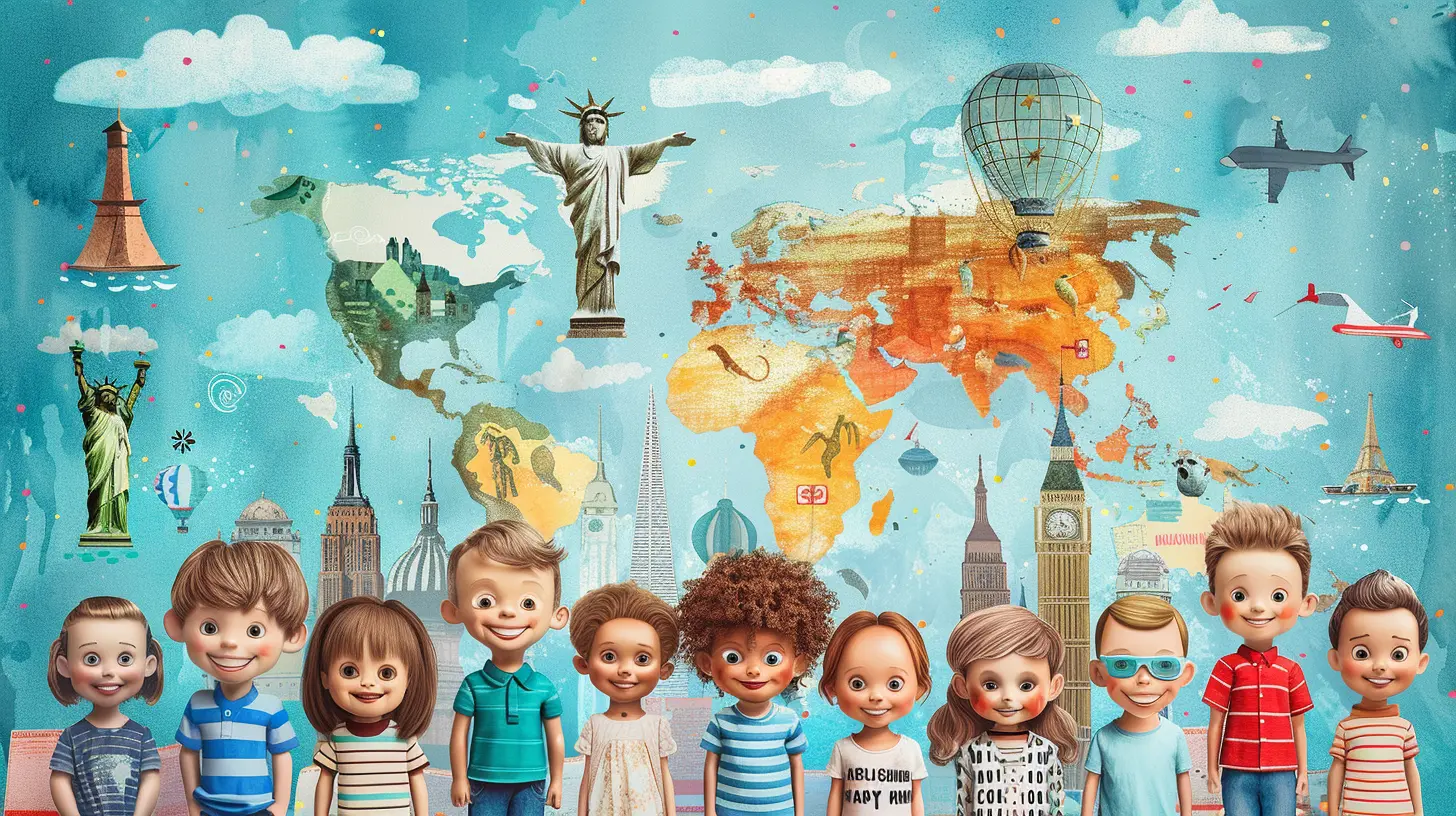Cultural Diffusion: How Ideas Cross Borders
18 January 2025
Ever wondered how pizza, originally from Italy, became a global favorite? Or how yoga, rooted in India, is now a morning ritual for millions around the world? This is all thanks to a fascinating process known as cultural diffusion. Ideas, beliefs, customs, and practices have been traveling across borders for centuries, often blending and adapting to the diverse societies they encounter.
But what exactly is cultural diffusion, and how does it shape the world we live in today? Let's dive into it.
What is Cultural Diffusion?
At its core, cultural diffusion refers to the spread of cultural elements—such as ideas, technologies, languages, and practices—from one group or society to another. It's like when you throw a pebble into a pond and watch the ripples spread out—except, in this case, the ripples are ideas, and the pond is the world.There are many ways that cultures can spread their influence. Sometimes it's intentional, like when traders introduce new products or when missionaries spread religious beliefs. Other times, it happens more subtly, like when people migrate to new places and bring their customs along.
Over time, cultural diffusion has played a pivotal role in shaping civilizations. Think about it: without it, we'd probably still be living in isolated bubbles, unaware of the incredible diversity and richness the world has to offer.
Types of Cultural Diffusion
Cultural diffusion doesn't always happen the same way. There are actually a few different types, each with its own unique path of spreading ideas. Understanding these can give us better insight into how cultural features travel across borders.1. Direct Diffusion
This is the most straightforward type of cultural diffusion. Two cultures come into direct contact—maybe through trade, war, or migration—and begin to exchange ideas, customs, and traditions. It’s like two neighbors trading recipes or borrowing tools. Over time, these shared exchanges can influence both cultures deeply.A great historical example of direct diffusion is the Silk Road, a network of trade routes connecting East Asia and the Mediterranean. Along these routes, not only were goods exchanged, but so were ideas, languages, and even religions.
2. Indirect Diffusion
In indirect diffusion, cultures don’t have direct contact with each other but are connected through a third party. Imagine you hear about a new fashion trend from a friend, who in turn learned it from someone else overseas. That’s indirect diffusion in action.For instance, the popularity of sushi around the world isn't just because people visit Japan and spread the word. It often spreads through media, restaurants, and other intermediaries that help introduce it to new audiences.
3. Forced Diffusion
Sometimes, cultural diffusion isn’t voluntary. Forced diffusion occurs when one culture imposes its ideas or practices onto another, often through conquest or colonization. While forced diffusion can bring about significant change, it can also lead to the loss of traditional customs and languages.A historical example is the European colonization of the Americas. European settlers introduced their language, religion, and customs to the indigenous populations, often suppressing local traditions and beliefs in the process.
Factors Influencing Cultural Diffusion
You might be wondering: what makes certain ideas or customs spread while others remain confined to their original cultures? Well, several factors come into play.1. Technology
In the digital age, it's no surprise that technology plays a massive role in cultural diffusion. Think about how quickly ideas spread nowadays thanks to the internet, social media, and smartphones. Whether it’s a viral dance on TikTok or a new food trend, technology accelerates the process of cultural exchange.Historically, technological advancements like the printing press or the steam engine also played key roles in spreading ideas across borders. For example, the printing press allowed for the rapid dissemination of books and ideas during the Renaissance, helping spread knowledge across Europe.
2. Migration
When people move from one part of the world to another, they bring their culture with them. This can include language, food, music, traditions, and religious beliefs.Take, for example, the influence of Latin American culture in the United States. Due to migration, Latin American music, food, and dance have become integral parts of American culture. Over time, these cultural elements have blended with local traditions, creating something entirely new.
3. Trade
Trade has always been a powerful driver of cultural diffusion. When goods are exchanged between nations, so too are ideas, technologies, and customs. Just think about how the spice trade not only brought exotic flavors to European kitchens but also introduced new cultural practices, technologies, and even scientific knowledge.
Examples of Cultural Diffusion in History
Let’s take a look at some key moments where cultural diffusion played a big role in shaping societies around the world.1. The Spread of Buddhism
Buddhism originated in India, but through cultural diffusion, it spread across much of Asia. Traders and monks alike carried Buddhist teachings along the Silk Road, reaching China, Japan, Korea, and Southeast Asia. As it spread, Buddhism adapted to the local cultures and traditions of each region, leading to the development of different branches like Zen Buddhism in Japan and Mahayana Buddhism in China.2. The Columbian Exchange
After Columbus's voyages to the Americas in 1492, a massive exchange of plants, animals, ideas, and technologies took place between the Old World (Europe, Asia, Africa) and the New World (the Americas). This process, known as the Columbian Exchange, had profound effects on both sides of the Atlantic.European powers introduced crops like wheat, rice, and sugar to the Americas. In return, the Americas gave the Old World crops like potatoes, tomatoes, and maize. These exchanges revolutionized diets and economies around the world. Imagine Italian cuisine without tomatoes or Irish cuisine without potatoes—unthinkable, right?
3. The Globalization of Music
Music is one of the best examples of cultural diffusion in action today. Genres like jazz, hip-hop, and reggae, which originated in specific cultural contexts (African-American communities for jazz and hip-hop, and Jamaica for reggae), have crossed borders and influenced musicians worldwide.Take K-pop, for example. Originally a South Korean music genre, it has now gained massive popularity globally, blending elements of American pop with Korean culture. This is cultural diffusion at its finest, where ideas blend and evolve into something entirely new.
The Impact of Cultural Diffusion on Modern Society
So, why does all of this matter? Cultural diffusion has had an undeniable impact on shaping the modern world. It's the reason why you can eat sushi in New York, listen to K-pop in Brazil, and practice yoga in Paris. But beyond the fun stuff, cultural diffusion has deeper implications.1. Cultural Blending
Cultural diffusion leads to the blending of traditions, beliefs, and practices. This blending can result in rich, diverse cultures that incorporate elements from multiple sources. For example, the United States is often called a "melting pot" because of the diverse cultures that have come together to form a unique American identity.2. Innovation and Progress
When different cultures share ideas, they foster innovation. For example, the sharing of scientific knowledge between Islamic and European scholars during the Middle Ages contributed to advancements in medicine, mathematics, and astronomy.3. Cultural Preservation and Loss
While cultural diffusion can create new, blended cultures, it can also lead to the loss of traditional customs and languages, especially when one dominant culture suppresses others. This is why cultural preservation efforts are so important in today’s globalized world.The Challenges of Cultural Diffusion
While cultural diffusion offers many benefits, it also comes with some challenges.1. Cultural Appropriation
One of the hot topics in today's society is cultural appropriation, which occurs when elements of a minority culture are adopted by a dominant culture, often without proper understanding or respect. This can lead to the commercialization or trivialization of important cultural symbols and practices.2. Resistance to Change
Not all cultures are eager to adopt new ideas or practices. Sometimes, cultural diffusion can be met with resistance, particularly in societies with strong traditions or values. This resistance can lead to conflicts or tensions between different groups.Conclusion: Embrace the Exchange
Cultural diffusion is a powerful force that shapes our world in countless ways. It brings us closer together, helps us innovate, and allows us to learn from each other. However, it also comes with its challenges, reminding us to approach cultural exchange with respect and understanding.The next time you enjoy a taco, watch a foreign film, or practice a tradition that originated half a world away, you’ll know that you’re participating in this centuries-old process of cultural diffusion. And who knows? You might just be spreading your own ideas and practices across borders without even realizing it.
all images in this post were generated using AI tools
Category:
Social StudiesAuthor:

Fiona McFarlin
Discussion
rate this article
17 comments
Galina McLean
What a delightful exploration of cultural diffusion! It’s fascinating how ideas can travel across borders, much like a friendly game of tag. Let's celebrate our global connections and the creativity that emerges from sharing perspectives. Keep spreading those ideas—who knows what amazing innovation might be just a conversation away!
February 2, 2025 at 2:05 PM

Fiona McFarlin
Thank you for your thoughtful comment! I completely agree—celebrating our global connections fosters creativity and innovation. Let's continue the conversation!
Yasmeen Jacobs
What a beautifully insightful article! Cultural diffusion enriches our world by fostering understanding and collaboration across borders. It’s inspiring to see how ideas can unite us, transcending differences and creating shared experiences. Looking forward to more discussions on this vital topic!
January 28, 2025 at 1:40 PM

Fiona McFarlin
Thank you for your thoughtful comment! I'm glad you found the article insightful. I look forward to more discussions on this important topic as well!
Kalani Hurst
Because ideas definitely need passports, right?
January 25, 2025 at 8:57 PM

Fiona McFarlin
Absolutely! Ideas may not need passports, but they do travel across borders, shaping cultures and sparking innovation in unexpected ways.
Ford Lewis
What a delightful exploration! It's amazing to see how cultures connect and thrive through the sharing of ideas. Truly inspiring!
January 25, 2025 at 12:59 PM

Fiona McFarlin
Thank you! I'm glad you found it inspiring. Cultural diffusion truly showcases the beauty of shared ideas and interconnectedness!
Dusk Bailey
Cultural diffusion: the ultimate reminder that innovation knows no borders, only bridges waiting to be built.
January 25, 2025 at 3:49 AM

Fiona McFarlin
Thank you! Indeed, cultural diffusion exemplifies how ideas transcend boundaries, fostering creativity and collaboration across diverse communities.
Myles Dodson
This article effectively highlights the complexities of cultural diffusion, emphasizing both the positive exchanges of ideas and the potential challenges that arise from cross-border interactions. Great insights!
January 24, 2025 at 12:57 PM

Fiona McFarlin
Thank you for your insightful comment! I'm glad you found the article's exploration of cultural diffusion's complexities valuable.
Thor McDowell
This article effectively highlights the significance of cultural diffusion in shaping societies. Understanding how ideas and practices transcend borders enriches our global perspective and promotes empathy. A must-read for anyone interested in the interconnectedness of cultures in today's world!
January 24, 2025 at 6:02 AM

Fiona McFarlin
Thank you for your thoughtful comment! I'm glad the article resonated with you and emphasized the importance of cultural diffusion in our interconnected world.
Fiona Gilbert
This article beautifully highlights the importance of cultural diffusion in our interconnected world. Understanding how ideas travel across borders enriches our perspectives and fosters greater appreciation for diverse cultures. Thank you for sharing these insights!
January 23, 2025 at 8:43 PM

Fiona McFarlin
Thank you for your thoughtful comment! I'm glad you found the article insightful and appreciate the importance of cultural diffusion.
Gunnar Torres
What a fascinating read! It’s amazing how ideas can travel across the globe, bringing diverse cultures together. It's a beautiful reminder of our shared humanity and the creativity that blossoms when we embrace each other's perspectives!
January 23, 2025 at 4:32 AM

Fiona McFarlin
Thank you for your thoughtful comment! I'm glad you found it inspiring. Cultural diffusion truly highlights our interconnectedness and the beauty of shared ideas.
Starling Wood
Cultural diffusion: it's like the world’s largest potluck dinner! Ideas travel like delicious dishes, sometimes mixing flavors that leave us scratching our heads, but hey, at least we’re never short on spice! Bon appétit, global thinkers!
January 22, 2025 at 9:53 PM

Fiona McFarlin
Absolutely! Cultural diffusion enriches our global tapestry, blending ideas and traditions in exciting and unexpected ways. Bon appétit indeed!
Marie McSweeney
Explore how ideas shape global cultures.
January 21, 2025 at 7:58 PM

Fiona McFarlin
Ideas are powerful agents of cultural diffusion, influencing traditions, languages, and social norms across borders. By sharing and adapting concepts, societies enrich their identities and foster global interconnectedness.
Holly McCray
Cultural diffusion enriches our world, showcasing the beauty of shared ideas and diverse perspectives. Embracing this exchange fosters unity and creativity, inspiring us to learn and grow together across borders!
January 21, 2025 at 12:38 PM

Fiona McFarlin
Thank you for your insightful comment! I completely agree—cultural diffusion truly highlights the richness of our shared humanity and the power of collaboration across diverse backgrounds.
Nala McMichael
Cultural diffusion: where ideas travel faster than my delivery pizza! Who knew borrowing a bit of someone else's culture could lead to a global flavor explosion? Keep spreading the love!
January 20, 2025 at 8:13 PM

Fiona McFarlin
Absolutely! Cultural diffusion enriches our lives, blending traditions and creating unique experiences. Let's celebrate the flavors of shared ideas! 🍕🌍
Nico McKittrick
Cultural diffusion is a powerful force shaping our global society. By sharing ideas across borders, we foster innovation and understanding, breaking down barriers. Embracing this interconnectedness enhances collaboration, enriches our perspectives, and ultimately drives progress. Let's celebrate the vibrant exchange of cultures!
January 19, 2025 at 9:05 PM

Fiona McFarlin
Thank you for highlighting the importance of cultural diffusion! Indeed, the exchange of ideas is vital for fostering innovation and mutual understanding in our global society.
Emmeline McMillen
Thank you for sharing this insightful article on cultural diffusion. It beautifully highlights the importance of understanding and embracing diverse perspectives, fostering connection and empathy in our increasingly interconnected world.
January 19, 2025 at 3:50 AM

Fiona McFarlin
Thank you for your kind words! I'm glad you found the article insightful and meaningful.
Brianna Yates
Imagine ideas as adventurous little squirrels, darting across borders with acorns of culture! From dance moves to dinner recipes, cultural diffusion is like a global potluck where everyone brings a dish. Let’s celebrate the delightful buffet of creativity that unites us, one quirky idea at a time!
January 18, 2025 at 1:24 PM

Fiona McFarlin
What a vibrant metaphor! Celebrating cultural diffusion as a global potluck beautifully captures the essence of shared creativity and the joyful exchange of ideas.
Zoey Castillo
Ah yes, because ideas definitely need passports to travel across borders, right?
January 18, 2025 at 5:15 AM

Fiona McFarlin
I appreciate the sarcasm! While ideas don’t need passports, their movement across borders can still face barriers and complexities.
MORE POSTS

The Science Behind Successful Group Work in Education

The Role of Interactive Media in Enhancing Distance Education

Mastering Time Management for Busy Educators

How to Use a Homework Planner to Stay on Track

How to Create a Dynamic Classroom Schedule

How to Incorporate Peer and Self-Assessment in Summative Evaluations

Enhancing Communication Skills Through Collaborative Learning

How to Foster Civic Engagement in the Digital Age

Creating a Positive and Inclusive Classroom Environment

The Benefits of Cross-Disciplinary Group Projects

Fostering Creativity and Innovation Through Collaborative Group Work